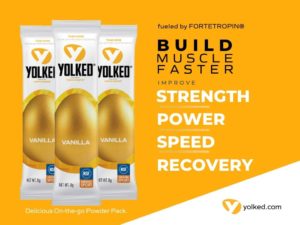
In this article, I want to talk a little bit about calf training. I want to explain, especially to those lifters out there who have naturally very thin and kind of stubborn calves, why they aren’t seeing any noticeable results and calf muscle gains in particular.
The genetic component obviously plays a pretty important role here, there is no question. If you aren’t blessed naturally with muscular, bulky calves, and if instead you have a kind of a thinner lower leg structure in general, with a longer calf tendon that causes your calf to be shorter from top to bottom, yes, it’s going to be somewhat harder for you to build them up significantly, but not impossible.
With a proper training plan in place, most people can make some really solid improvements in terms of gains and their calf development if given enough time and determination.
The main reason why most of you out there with naturally thin calves just don’t see the gains that you’re after, in my own view, is because you’re not calculating your calf training volume properly. You see, what most people do when calculating their complete weekly training volume is that they assign a specific number of sets and reps to larger muscle groups, which in their opinion have the most potential for growth. Then they take smaller muscle groups and assign to them what they think is enough in terms of sets and reps in order to activate them.
They see calves as a “small” muscle group and say to themselves that they should be trained with the same workload as some other small muscle groups, like the biceps and the triceps. But the problem with that approach is that, unlike the calves, all those smaller upper body muscles are getting a large amount of secondary stimulation during big upper body compound exercises, whereas outside of direct calf work the calves aren’t really being hit hard at all.
Your biceps are being stimulated for growth during pull-ups, pull-downs, rows; your triceps are being hit hard on every single set of chest and shoulder pressing; your delts are stimulated to some degree on pretty much every single upper body lift that you do in general. And even when you want to target one specific area of your back, let’s say your lats, usually other areas of your back like your traps or your smaller mid back muscles are being involved as well.
When it comes to calves, however, even when you perform a big compound leg exercises like squats, leg press or Romanian deadlifts, your calf muscles only act as dynamic stabilizers during those movements, which means that they don’t actually change in length during the movement, meaning stretch and squeeze, so you’re not getting much of the growth stimulus there.
Let’s take triceps as an example. Let’s say you’re doing eight sets of horizontal pressing movements for chest per week and four sets of overhead pressing for shoulders – that’s twelve sets per week where your triceps are being heavily stimulated, on top of all the isolation work on them you’re doing as well. So if you’re doing six sets of triceps extensions per week, and then let’s conservatively say that each of those compound pressing exercises only counted as half a set for your triceps, that’s still twelve total units of volume that you’re doing per week for your triceps.
So, if you’re putting your calf isolation work in the same category as your triceps, and you’re doing six sets for your calves, on the surface it might appear that you’re doing the same amount of work when in reality you’re only doing half as much.
In addition to all of the above, there are two other important things you have to consider here, with first being that the calves aren’t actually as small of a muscle group as most people tend to think. If you really compare the total mass of let’s say your biceps to your calves, you’ll see that your calves are quite a bit bigger. There’s the gastrocnemius, which is that bulky part of your calf, which has both a lateral and a medial had, and then you have soleus that runs underneath and on the sides, which although appearing smaller, is actually structurally larger than the gastrocnemius.
The point here is that rather than equating your calves to your biceps or to your triceps., it’s actually more accurate to compare your calves to your entire upper arm as a whole.
Secondly, most people don’t really train their calves with nearly as much intensity on each set as they really could be. The calves are actually a really strong set of muscles, and when you load up the true amount of weight that they’re capable of handling and then you train right up near failure, maybe within the rep or two.
The calves are a really uncomfortable muscle group to train. Most lifters out there just load up some random amount of weight, and then they pump out some quick reps at the end of their leg workout until it starts to burn and then they stop.
“What you should do when you train is you should slow down your rep/movement tempo, letting your heels hang down for one to two seconds at the bottom, and then drive right up onto your toes as hard as you can, hold for a second at the top for maximum peak contraction, and then lower back down..”
Calf training is legitimately hard. In my opinion, it’s a lot more challenging than training your biceps or your triceps or your shoulders.
So, when you add all of this up, the bottom line is that your calves just aren’t getting enough of total stimulation during the week, period. I know that it sounds pretty straightforward, but that’s basically really what it comes down to. Most people don’t even realize that they’re undertraining them, because again, they’re treating their calves in the same way as their other smaller muscle groups, when in reality that isn’t a fair comparison at all.
Now in practical terms, it’s really up to you what you choose to do with this information because it ultimately depends on your personal goals and the time and the effort investment that you’re willing to make. But if you are someone who wants to fully optimize their calf development, and you aren’t seeing the results you want right now, then you likely just need to buckle down and really hit them harder, period.
As a general rule, I recommend usually between six to eight direct sets for calves, but if your calf development is really lacking and if you’re seeing a slow progress or no progress at all, I’d go for eight to twelve direct sets. Now, for maximum gains, I’d recommend ten to twelve direct sets per week for calves alone.
The way you can break it up is you can do six sets per workout, twice a week, which is pretty reasonable. The other option, if you want to be more time efficient is that you do keep a volume a little bit lower, so you stick to six to eight sets of direct calf work per week in total, but you really ramp up the intensity level per set by going all the way to failure.
I don’t recommend training to failure all the time for all muscle groups, but for those muscle groups that are considered “smaller” or secondary to some people, going to failure is likely to be fine since it won’t stress your body as a whole in the same way that big compound lifts taken to failure is going to.
Whatever you do here, one thing that you should always incorporate, in all of your lifts, especially if you want to see your calves growing, is you have to apply progressive overload. You want to be consistently increasing the weight and the reps over time. Make sure your form is solid like I mentioned before. Good, controlled execution of reps, to maximize the stress on the calves, and to minimize the involvement of the Achilles tendon.
Another important thing you have to be here is patient. No matter how you go about this, the reality is that there is a big genetic component involved when it comes to building up your calves. If you have naturally skinny calves, then it’s naturally going to take many months or even a year or so of consistent and hard calf training to truly build them up to what would be considered an impressive level.
Thanks for reading guys. I hope this advice was helpful. Now if you want a complete breakdown of how you should train all your major muscle groups for your body, including step by step routines for beginners, intermediate, and more advanced lifters, you can contact me through my PT page.


